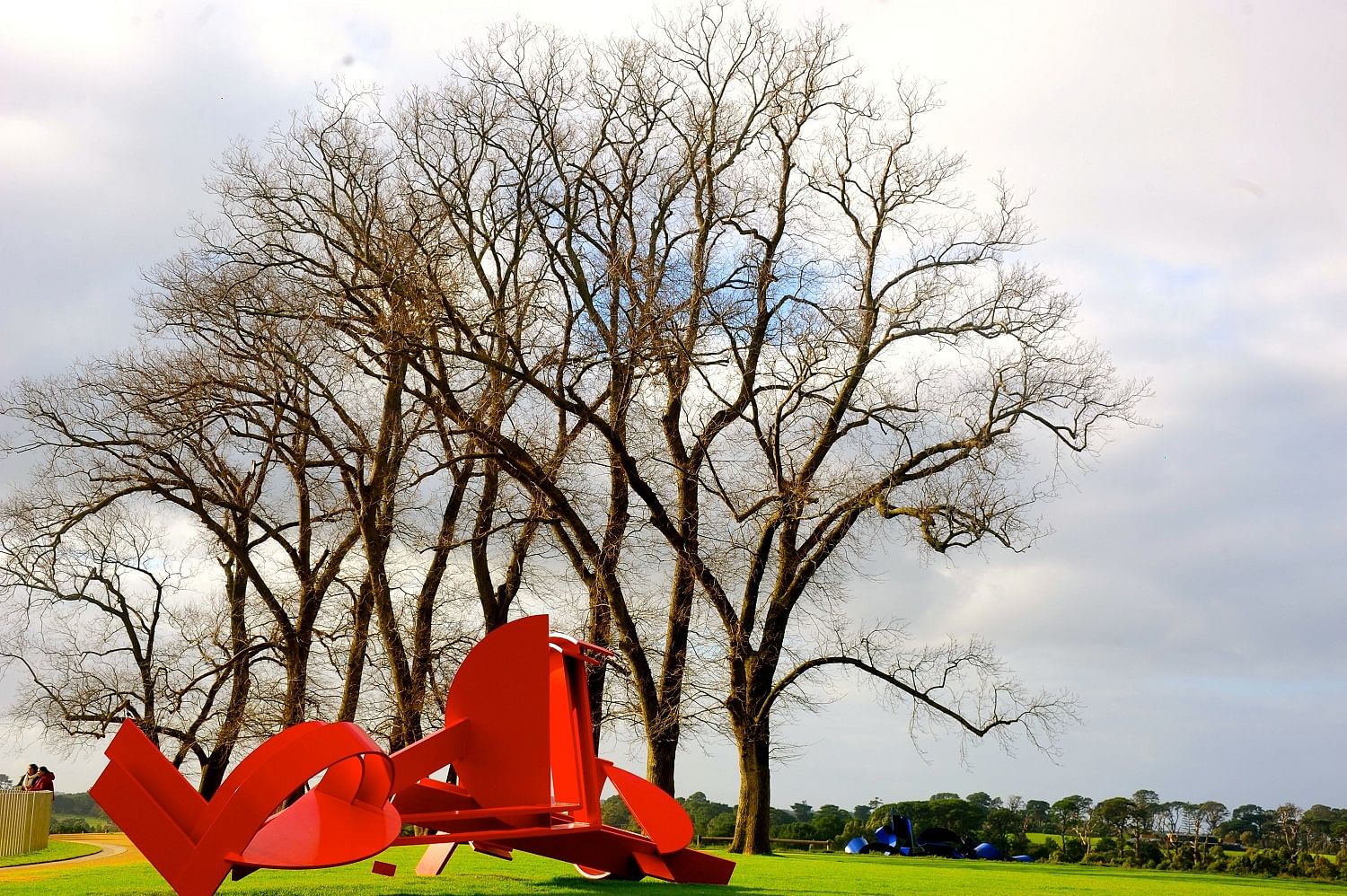
Car parking lots are not meant to be intrigue-triggers. Or art thought- prompters. Car resting spaces are meant to be staid — formal, functional, angled for convenience. But the Point Leo Estate in Australia’s Mornington Peninsula strays from the bog-standard. Art accosts even before the vacant parking space beckons. The horseshoe loop around the lot emerges out of a bunker-like curved wall. Sober concrete with no embellishment. Until one notices the curves after a quick squint. What appears utilitarian is an abstract interpretation of wine pouring from a bottle. A bunker-like wall around a vineyard had never-ever been so arty before.
Then, the large black arch calls for attention. The undulating gigantic flanks of the sculpture sitting on a stone roundabout with clouds peeping in and out of its horizontal hollow. That’s the Inge King (1915-2016) signature ‘Grand Arch’ that was conceived in 1983 and enlarged three times previously at various locations. Among the green vineyards, a figurative sculpture would have been predictable. But Inge, who died at age 100, never preferred chiselling human contours. Co-founding the influential Centre 5 group, the German-born Inge was at the forefront of the development of non-figurative sculpture in Australia.
Goes on
‘Inge’s Arch’ is merely the introduction to a long, sprawled sculpted narrative of Australia’s largest sculpture park. Spread over 134 hectares, Point Leo Estate, which houses world-class cellar door and fine dining, has nearly 50 large sculptures curated by Geoffrey Edwards, former director of Geelong Gallery and former senior curator of International and Australian sculpture at the National Gallery of Victoria. With a $10 entry fee, the visitor steps into the serpentine paths that meander through the gardens — the Short Walk takes around 40 minutes; the Long Walk more than an hour. There is no guided tour, but rectangular granite plaques at the foot of each sculpture add the essential details.
That frosty afternoon, with the wind whistling over the blue waves, Roger Lancia, general manager of the estate, pulled a black parka over his crisp-white shirt and turned into an art guide. “There’s the ‘Big Boy’ by Zadok, ‘Luke’ by Tony Cragg, Deborah Halpern’s mosaic, ‘Riff’ by Meadmore… And, yes, there’s ‘Laura’.” I had heard of Laura, the 14-year-old Mediterranean girl from Barcelona whom Spanish artist Jaume Plensa refers to as ‘a timeless beauty’.
The cast-iron eyes of Laura close in a dream-state position, emphasising the interior path, the world of dreams and ideas. I walked towards Laura at Point Leo. She stood in the middle of a circular garden as if lost in a deep reverie, her elongated head acquiring different dimension depending on where she is being looked from. Exaggerated at one angle, narrow from another, and fully realistic from the side.
Behind the mammoth but meditative Laura is a rather menacing, frightening man with a globular torso, aggressive stance and cautionary gesture. The gigantic figure of anonymous authority dwarfs the tiny ‘everyman’ figure who looks defiant and gestures bravely. Sculpted by Todd Stuart and titled ‘Shhh... Don’t Tell the World’, this 2015 work is a grim reminder of George Orwell’s fictional accounts of totalitarian oppression.
Too close to the water is a corten steel ‘Big Boy’ by Zadok Ben-David, who calls Yemen, Israel and the United Kingdom his homes. ‘Big boy’ originates in Ben-David’s photograph of a boy with a soccer ball glimpsed in a street in Portugal. The soaring profile is hand-cut from a single sheet of corten steel in such a way that this two-dimensional image creates the illusion of a third dimension.
In close proximity is ‘To The Centre’, a 2,000 corten steel mandala-like sculpture by Greg Johns. Inspired by ancient belief systems and melding it with physics and philosophy, Australia-born Johns cajoles metal into rhythmical and supple configurations reminiscent of a Celtic knot.
“That’s the Riff,” Lancia, still doubling up as an art guide, pointed to a blue painted steel that is minimalist, spontaneous and imposing simultaneously.
Born in Melbourne and trained as an industrial designer and engineer, Clement Meadmore (1929-2005) takes forward his love for jazz and his professed belief that “...a sculpture is a presence inhabiting the environment.”
That frosty Victorian day, I was hurrying through the Short Walk when I saw the horizon. Not that line where the earth and the sky embrace, but ‘Horizons’, a painted steel-and-bronze sculpture that is intended, as the title suggests, to be seen against the sky and natural horizon. Its stylised stair element rises to an animated configuration with cloud, rainbow and landscape symbols. Anthony Pryor’s 2011 sculpture seems to move forward, yet its sweeping curvilinear elements lead the eye into space.
Hear the words
In Point Leo Estate, my eyes were wandering. From the hollow stylised steel men to human forms made of stacked slate, a sign that reads ‘Private Poetry. Trespassers Welcome’, a fibreglass vessel and a bird floating in a waterbody to tall columns of reflective steel that become a playground for an intense interplay of light and elusive shadows.
In the unending green expanse of Point Leo Estate hemmed with emerald grapevines, turquoise peninsula and flowering native Australian gardens, there was no hint of aboriginal art — those oft-repeated dots against oranges and blues. “We shall soon have one,” Lancia chips in as if reading the question in my mind. He, however, remained secretive about its theme, artist and medium. “It will be installed in August. And it will be ‘shocking pink’,” Point Leo Estate’s general manager reveals only the colour. Pink. Nothing more.
I wait for August. And the shocking pink aboriginal sculpture in Mornington Peninsula’s Point Leo Estate.